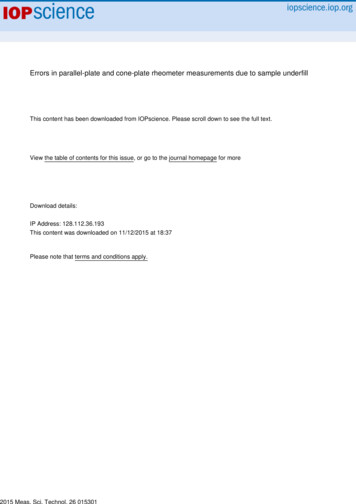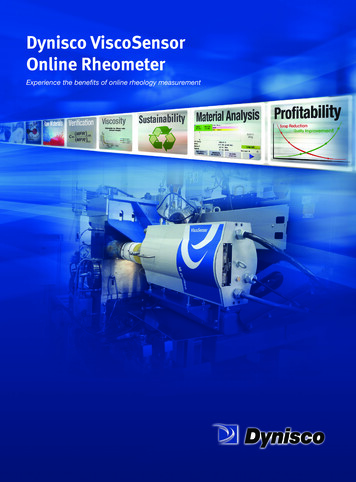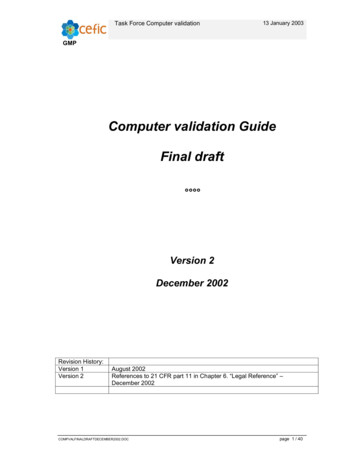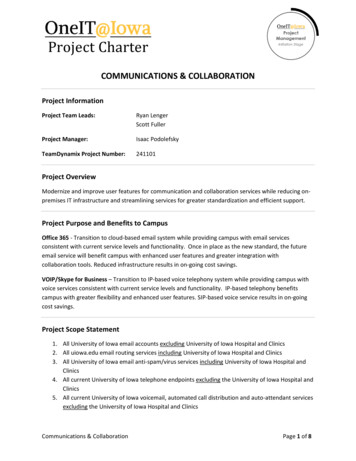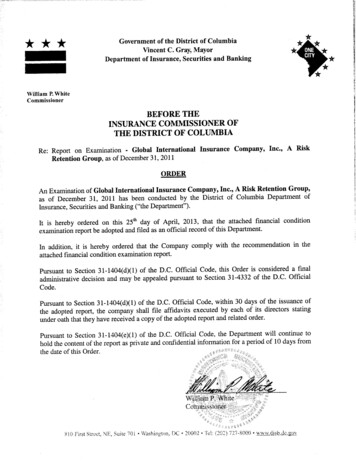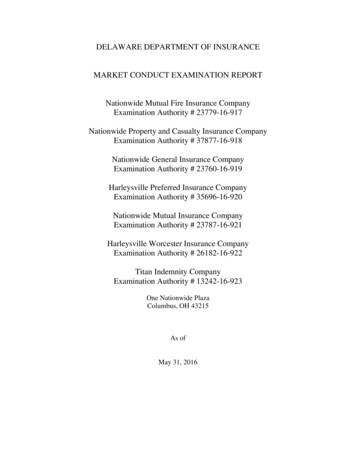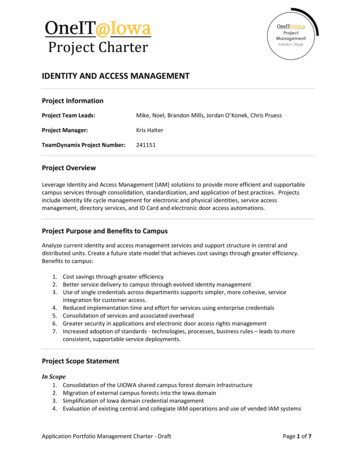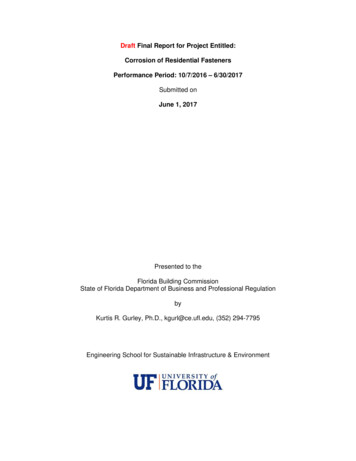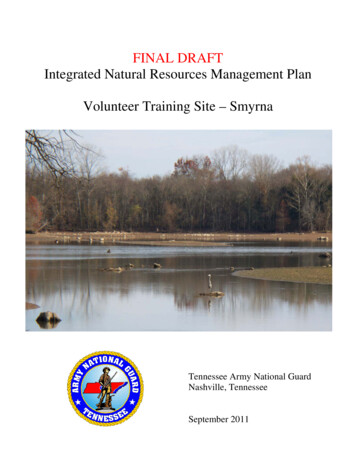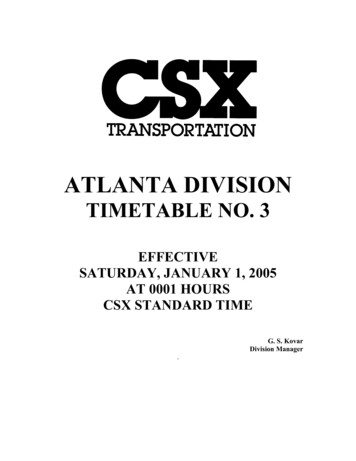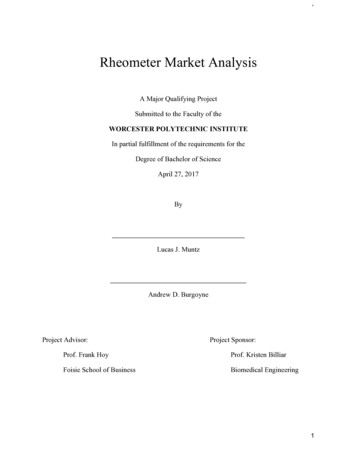
Transcription
1Rheometer Market AnalysisA Major Qualifying ProjectSubmitted to the Faculty of theWORCESTER POLYTECHNIC INSTITUTEIn partial fulfillment of the requirements for theDegree of Bachelor of ScienceApril 27, 2017ByLucas J. MuntzAndrew D. BurgoyneProject Advisor:Project Sponsor:Prof. Frank HoyProf. Kristen BilliarFoisie School of BusinessBiomedical Engineering1
2Table of ContentsRheometer Market AnalysisTable of ContentsTable of FiguresAbstract1. Introduction2. Background2.1 History of the Rheometer2.2 Types of Rheometers2.3. Rheological Measurement2.4 Marketing Concepts2.5 Make vs. Buy Decision Making Process2.6 Industry Competition2.7 Barriers to Industry Entry2.8 Outperforming the Market2.8.1 Cost Leadership Strategy2.8.2 Differentiation Strategy2.8.3 Focus Strategy2.8.4 Stuck in the Middle2.8.5 Strategy Risks2.9 The Commercialization Cycle2.10 Business Model Canvas3. Methodology3.1 Research3.1.1 Background Research3.1.2 Intellectual Property3.1.3 Competition3.1.4 Commercialization3.1.5 Consumer Research3.2 Questionnaire Development3.3 Developing a Commercialization Strategy3.3.1 Opportunity Recognition3.3.2 Feasibility Analysis3.3.3 Project Plan3.4 Recommendations4. Results4.1 Survey for Rheometer Manufacturers4.2 Survey for Rheometer Users4.3 Product Comparative 838394040424243444548512
35. Conclusions585.1 Canvas Business Model Analysis585.1.1 Start-Up Business Model585.1.2 Licensing Business Model605.1.3 Joint Venture Business Model615.1.4 Holding Business Model615.1.5 Abandoning Business Model625.2 Discussion of Survey Findings635.3 Limitations and Further Research636. Interdisciplinary Reflections647. Recommendations658. References65Appendix A: Survey for Rheometer Manufacturers68Appendix B: Survey for Rheometer Users70Appendix C: Business Model Canvas73Appendix D: Start-up Business Model Canvas74Appendix E: Licensing Business Model Canvas75Appendix F: Joint Venture Business Model Canvas76Appendix G: Franchise Business Model Canvas77Appendix H: Holding Business Model Canvas78Appendix I: Abandoning Business Model Canvas79Appendix J: Market Data for Figure 12: Types of Rotational Rheometers on the Market80Appendix K: Product Data for Figure 13: Types of Rheometers Sold by Company83Appendix L: Market Data for Figure 14: Rheometer Applications by Material (Sourced fromBrookfield Engineering)913
4Table of FiguresFigure 1: A Cone & Plate Measurement System . .Page 11Figure 2: Cone & Plate vs. Parellel Plate Measurement System . .Page 12Figure 3: Make or Buy Decision Matrix (Martin, 2015).Page 17Figure 4: The ARES Series Rheometer . .Page 19Figure 5: A Rendering of an Oscillating Piston Rheometer . Page 23Figure 6: Schematic of VROC Rectangular Slit Microfluidic Cell . .Page 24Figure 7: Pressure as a Function of Position for Low and High Concentration Glycerol Samples(http://www.rheosense.com/technology, Figure 2).Page 25Figure 8: Three Generic Strategies (M. Porter, 1998).Page 31Figure 9: The Commercialization Cycle (Professor Schaufeld).Page 33Figure 10: Cognitive Processes of Opportunity Recognition (Baron, 2006).Page 42Figure 11: Types of Rotational Rheometers on the Market . .Page 54Figure 12: Types of Rheometers Sold by Company . .Page 56Figure 13: Rheometer Applications by Material . .Page 584
5AbstractThe goal of this project is to provide recommendations for the commercialization of eccentricviscoelastic rheometry. The project team accomplished this task by conducting research into thecurrent market by developing a set of interview questions to survey industry professionals.However, the data collected needed to be supplemented by a product comparison study in orderto determine the feasibility of commercialization. These results allow us to reach conclusions onthe potential market impact of this method and the potential barriers to entry.5
61. IntroductionIn the biomedical engineering industry, there is an increasing need to measure theviscoelastic properties of biological materials. When viscoelastic materials undergodeformation, they tend to exhibit varying levels of both viscous and elastic characteristics overtime. One example of a viscoelastic material is honey because it is able to resist shearing andstrain over time as stress is applied. Therefore, it is necessary to measure the changes inviscoelasticity to understand how biological materials can be used in the real world. With theconstant development of new biological materials and methods, the accurate measurement ofviscoelastic properties provides a better understanding of their application. A RotationalRheometer can take accurate measurements of the sensitive variations in viscoelastic properties,and is the focus of this project.Professor Heather A. Cirka and Professor Kristen L. Billiar patented (publication#US20140102180 A1, 2014 & 2016) a new rheometric technique for biological samples. Thisnew technique called eccentric viscoelastic rheometry allows for more accurate measurements ofsubtle viscoelastic properties in smaller, uniform or anisotropic samples. Quantifying theviscoelastic characterizations of soft tissues biopsies and fibrous protein gels can help usunderstand the complex systems at work in tissue development, wound healing, diseaseprogression, and cell-mediation of engineered tissues. Additionally, eccentric viscoelasticrheometry can help analyze the viscoelastic behaviors in newly formed tissues and protein gelsthat are often unstable and cannot be measured by standard rotational rheometry.The purpose of this project is to provide recommendations for the commercialization ofeccentric viscoelastic rheometry. Our comprehensive marketing strategy targets current users ofrheometric technology and possibly identifies new users in the future. In order to develop a6
7strategy, our group must assess the feasibility of the method in the current market and produce acomprehensive analysis of its practicality. The strategy includes an analysis of the differentbusiness model canvases generated, the current rheometers used in the market, and the associatedrisks of bringing EVR to market. Additionally, our project assesses the current strengths andweaknesses of the patent, while identifying similar patents and the threat they pose to iscommercialization.Ultimately, the goal of the project is to gather the necessary information to understand ifthere is a significant need for eccentric viscoelastic rheometry. Based on previouscorrespondence conducted during the initial stages of this project, we found a lack of awarenessof the current market, its size and the potential for a rotational rheology product line. Hence, thisproject was born. By providing a commercialization strategy our team determines market sizeand potential, and recommend an optimal approach for bringing this method to market.2. Background2.1 History of the RheometerThe word rheometer translates from Greek as a device for measuring flow. The origin ofthe device itself dates back to the 19th century. Early rheometers were devices that measuredelectrical currents but that term and practice was later replaced by the galvanometer. The nextevolution of the term dealt with the measuring of fluids (especially blood) but as the medicalfield evolved and needed to diversify; its sampling techniques had to evolve too. Thus the termand practice of viscometer was born to directly relate to fluid measurement analysis. Currentrheometers are almost as diverse as the substances and forces that they measure.7
8TA Instruments, a leading developer of rheometers, defines this device as one that“contains the material of interest in a geometric configuration, controls the environment aroundit, and applies and measures wide ranges of stress, strain, and strain rate.” What this means isthat the instrument itself must be adjusted to the specific material it is measuring. There areseveral different types of rheometers, however we concentrated our research on rotational orshear rheometers since our sponsor used a rotational rheometer with EVR2.2 Types of RheometersThe main category of rheometers our group is concerned with, rotational or shearrheometers rely on rotational motion to achieve a shearing effect. In order to achieve the shearingeffect in a rheometer, one must apply a force to the sample through rotation or other movement(Barnes, 2005). The first method was introduced in 1888 by Maurice Couette and the secondmethod was introduced in 1912 by George Searle (Barnes, 2005). Using the two methods ofmeasurement rotational rheometers can be classified into four different categories. A simpledynamic shear rheometer, or DSR can be used to measure the characteristics of a wide range ofmaterials under varying conditions of temperature, stress, and strain. Rotational cylinderrheometers have two cylinders, one inside the other where the inside rotates at a known speed forcalculating shear stresses on a sample. A pipe or capillary rheometer runs liquid through a tubewith set dimensions and flow rates to calculate the shear rate on the tube. Finally, the last type ofrheometer, parallel-plate or cone and plate rheometers use rotating plates or a shallow cone andplate with liquid between them to measure the shearing forces on the sample.A dynamic shear rheometer or DSR has remained one of the most commonly usedrheometers commercially and in industrial labs. “The original DSR set new standards in asphalttesting technology offering precise and accurate unattended operation.” (Cooper Technology)8
9Since 1993 rheometers have been used to characterize and understand the rheological propertiesof asphalt binders making them fundamental to forming the chemistry and predicting theperformance of these materials (Eschbach, 1993). In general, dynamic shear rheometers offergreater ease of use and performance than most types of rheometers. DSR’s can be designed andoptimized so that they work with any specific material, making it a versatile option when itcomes to rheological measurement.Sometimes referred to as the “Couetter” rheometer, the rotational cylinder rheometerconsists of two parallel plates curved to form coaxial cylinders (Eldrich, 1978). While the insidecylinder is stationary, the outside cylinder rotates at a set velocity with fluid between them.When the velocity of the cylinder is changed the shear rate of the fluid can then be determinedfrom the change in consistency of the fluid (Gwidon, 2016). Such instruments have been widelyused for obtaining rheological data on low-viscosity fluids. For example, rotating cylinderrheometers are used to measure the viscosity of motor oils at -18 degrees celsius in order toassess its performance in engines under European and North American conditions (Gwidon,2016). Additionally, rotational cylinder rheometers were used to acquire the first quantitativemeasurements of raw rubber’s rheological properties (Eldrich, 1978).The third category of rheometers is the pipe or capillary rheometers. Capillary rheometersare one of the oldest methods for measuring the viscosity of fluids. During the 1920s and 1930sthese types of rheometers were regularly used by the founders of modern rheology to quantify allkinds of complex fluids (Eldrich, 1978). Unlike most rotational rheometers, capillary rheometersare less suitable for fluids whose viscosities vary based on the applied stress or force (Gwidon,2016). Since capillary rheometers are based on the principle that only a specific volume of liquidwill flow at one time, the flow through the capillary must be laminar to accurately measure the9
10time. Only by accurately measuring the time it takes for a specific volume of liquid to flowthrough the pipe will you get the kinematic viscosity for that fluid (Gwidon, 2016).The last type of rotational rheometer, that Professor Cirka and Professor Billiar used withtheir new rheometric measurement technique, is a parallel-plate rheometer. Conceptually one ofthe simplest rheometers, the parallel-plate rheometer rotates one plate at a known velocityparallel to a fixed plate at a set distance. The rate at which the sample is being sheared can thenbe calculated when you divide the velocity of the moving plate by the distance between them(Elrich, p.245).However the ideal scenario, where shear rates can be calculated so effortlessly, is notassumed when using most commercially-available instruments. Instead, most users ofcommercial rheometers pre-arrange their sample geometrically so that the resistance to rotationcan be easily determined (Kaukler et al., p.1). This disconnect between the ideal and the realworld happens because the shear rate is directly dependent on the specific radius from the centerof torque. Therefore, the parallel-plate sensor system cannot be characterized by a single shearrate but by a range of shear rates from zero radius to the maximum radius of the plates(Schramm, p.58).2.3. Rheological MeasurementFor the purpose of this project, we concentrate on the parallel-plate rheometer type.When using this type of device, sample geometry measurement techniques fall into three basiccategories. These are: cone & plate, parallel plate, and cup & bob.The Cone & Plate method is often considered the ideal measuring system because it iseasy to clean and can measure samples of a very small size and volume. In this method, a10
11sample is placed on the lower plate and measured using relations to the Cone Angle and Conediameter as shown in the following figure.Figure 1 – A Cone & Plate measurement systemIn this method, the sample should fill or expand to the cone diameter. A sample that i
rheometer, parallel-plate or cone and plate rheometers use rotating plates or a shallow cone and plate with liquid between them to measure the shearing forces on the sample. A dynamic shear rheometer or DSR has remained one of the most commonly used rheometers commercially and in industrial labs. “The original DSR set new standards in asphalt testing technology offering precise and accurate .
